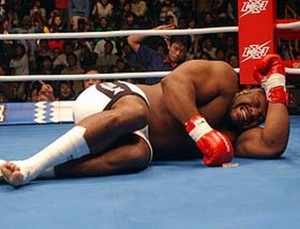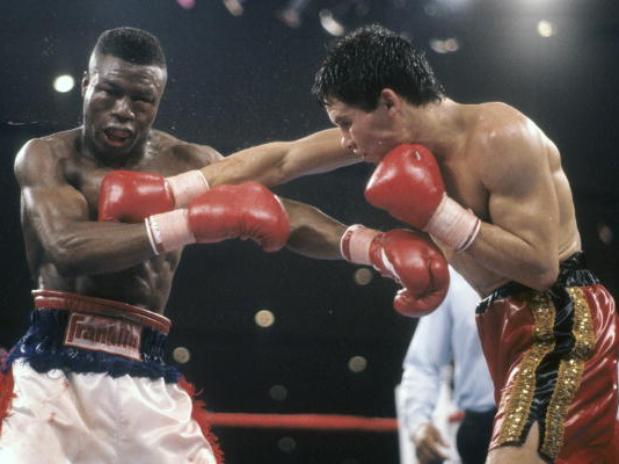For something that is so central to success in combat sports, there is a surprising paucity of information on what we colloquially refer to as the “chin” of a fighter. Why are some individuals able to sustain a life-altering beating, while others turn into Bambi-on-roller-skates if they so much as think about getting hit?
In order to understand the mechanics of punch resistance, one has to first understand the biochemistry of head trauma.
“It’s really a multi-factorial process when you deal with concussions,” says Dr. Anthony Alessi, Associate Clinical Professor of Neurology at the University of Connecticut and 2009’s Ringside Physician of the Year. “Potassium is inside the nerve cell, and sodium and calcium are outside the cell. What happens is, when you have a concussion, you upset the membrane. Calcium begins to flow into the nerve cell, which then causes swelling and damage to the nerve cell.
“Let’s say there’s a storm, and the concussion is the storm. It causes a rupture in your basement wall, and now you’ve got water flowing into your basement. That rupture in the basement wall is like rupturing the nerve cell. Now you’ve got all this water flowing in—which would be the calcium—and the only way to get it out is to pump it out. And that’s what the nerve cell does.”
Taking this analogy further, it seems as though each individual has his own distinct internal wall governing how much trauma he can endure before the body is forced to temporarily shut off the power. Whether one’s personal wall has been constructed from diamond or candy class is purely down to genetic luck.
“The nerve cell has pumps to pump the calcium out so that it can get back to being balanced,” adds Dr. Alessi. “The body diverts energy to get these pumps working. That’s why knockouts occur, because the brain is saying: ‘Listen, I gotta shut it down here and get this thing going again.’ If you get another storm before you’ve even repaired the first one, you’re going to have an overwhelming amount of calcium rushing in, and that can sometimes even result in death.”
There are a number of different theories as to why certain fighters are blessed with a more robust set of whiskers than others. Some have argued that when we talk about the quality of a fighter’s chin, we are really talking about neck strength. Dr. Matt Pitt, in a 2010 article for Sherdog.com, argues that the sternocleidomastoid muscles—on either side of the neck—determine one’s capacity to take a punch.
“[The sternocleidomastoids] are prominent. Unfortunately, they are also isolated,” claims Dr. Pitt. “It is not surprising then that we rarely see the thrower of a well-placed punch to the head grasping his hand in pain and stumbling back in amazement as his opponent casually flexes his [sternocleidomastoids] and smiles; the muscular arithmetic is firmly in the thrower’s favor.
“When a punch of sufficient force strikes the face, it accelerates the front of the cranium back into the frontal lobes of the brain. This is the irreducible sweet science of brain injury. A gentle blow to the frontal lobes causes various degrees of central nervous system sedation—it stuns the brain—and a blow of sufficient force simply shuts the brain off.”

Intuitively, this appears to make a lot of sense. But what about fighters who have large neck muscles yet appear to be walking on stilts whenever they absorb anything stronger than a light breeze? Bob Sapp’s neck looks like it was designed by a caricaturist, but in recent years he has spent more time in the fetal position than a newborn baby. How to make sense of these apparent anomalies?
“Absolutely, neck muscles are important in the type of concussion that results from whiplash,” states Dr. Alessi. “However, it doesn’t help to avoid a direct blow. It only helps in certain instances. The brain has a certain threshold for damage and different brains have different thresholds. There are different tolerances within the brain and within nerve cells to different stressors, including head damage.”
Trawling through forums and comments sections, a popular view within the MMA community seems to be that there is a connection between mental strength and punch resistance. It’s a curious idea, seemingly borne out of wishful thinking more than anything else. If boastful conversations about male genitalia have taught us anything it’s that we like to give and take credit for mere accidents of birth. Indeed, in boxing and MMA the sturdiness of one’s chin has almost replaced penis size as an indicator of masculinity. Fans are eager to credit a fighter for the fact that he possesses a granite chin, attributing it to mental strength as opposed to something that is entirely beyond his control.
“[Mental strength] doesn’t play a role in it. That kind of mentality is scary more than anything,” argues Dr. Alessi. “Those are the kinds of people who are going to stay in there no matter what, and those are the guys who end up with the most damage…. They’re willing to die.”
An interesting fact about this issue is that a fighter’s capacity to absorb damage tends to diminish over time—a fact which supports the idea that the composition of one’s chin is multifactorial. Chuck Liddell is one such fighter who made the journey from extreme durability to almost-comical fragility. As his career progressed, watching the deterioration of Liddell’s punch resistance was almost as compelling as the fights themselves.
“Some fighters believe the more you get hit in the head, the more you build up an immunity to damage,” Dr. Alessi points out. “These people think: ‘The more I get hit, the tougher I get.’ But it’s more like: The more you get hit, the dumber you get. That’s one of those gym fallacies that has been going around for years.
“The nerve cells are almost like long, fine threads in the brain. What is happening is, with a concussion, you are shearing those nerve cells and rupturing those membranes… Referring back to the threshold of the brain for injury, each time the brain is injured, the threshold goes down, making it more susceptible to further damage.”
In light of how little control we have over our capacity to absorb punishment, it seems strange that we revere toughness perhaps more than any other fighting quality. Much like an exposed magic trick, reducing the chin to biochemical equilibrium seems as though it would undermine our sense of reverence.
Chalk it up to my love of science, but watching a Julio Cesar Chavez or a Roy Nelson endure a harrowing beating only to keep moving forward remains an awe-inspiring sight even when one understands the underlying processes.
A draft of this article was first published at Bleacher Report. You can view that version here. All quotes obtained firsthand unless otherwise noted.

